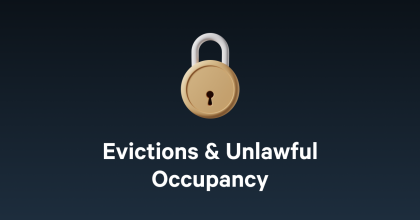Dealing with unlawful occupants in rental properties is a challenging and time-consuming task that every property manager and landlord may have to deal with at some point in time. Whether it’s a squatter who has unlawfully settled in a property or a resident who has violated the lease terms, these scenarios can happen even with preventative measures in place.
In this post, we will explore the definitions of squatter and resident eviction, highlight preventive measures Vantage Horizon has implemented to protect investors, and outline ways to reduce your exposure to adverse outcomes from an eviction process.
Finding the Right Property Management Partners
Maintaining a high occupancy rate and maximizing returns for investors starts with finding the right property management partner. Vantage Horizon works with experienced third-party property managers to operate in each market, and these professionals have the expertise and knowledge to handle all aspects of property management, from tenant screening and lease agreements to maintenance and repairs.
In the case of an unlawful occupant or lease violation for non-payment, Vantage Horizon works closely with these partners to ensure they execute the proper steps to resolve the situation per our established playbook.
Preventative Measures
Before a problem can even present itself, property managers proactively implement various measures to prevent unauthorized individuals from occupying properties, such as installing digital locks with one-time access codes to ensure only authorized individuals can enter the premises. Managers also perform regular wellness checks at vacant properties to identify unauthorized occupants before they become a significant issue. So, even if a trespasser can gain entry and occupy a property, these routine checks ensure they are detected early, and the property manager can move to resolve the situation.
Squatter Evictions
If an unauthorized individual is found occupying a property, managers promptly alert the local authorities and follow the standard procedures based on local laws. Dealing with squatters can be a challenging experience, and it’s important to note that the process of removing squatters can vary significantly from state to state.
Resident Evictions
Resident evictions occur when a tenant violates the lease terms, fails to pay rent, or does not vacate the property at the end of their lease. Property managers typically terminate the lease and file for eviction if a resident is two months behind on rent payments (60 days plus a buffer period for late fees).
Eviction Process Overview
The eviction process involves several steps, varying in duration depending on the jurisdiction and type of eviction. Here is a general overview:
1. Rent Demand: If it is a resident eviction, a legal demand for payment or vacancy is issued, providing a specified date for compliance. The demand period typically ranges from 3 to 30 days, depending on the jurisdiction.
2. Filing: An eviction case is filed with the court once the demand period expires. The filing process takes 1 to 10 days, and the resident usually has 5 to 14 days to respond.
3. Summons: The court serves a summons to the resident, typically taking 5 to 21 days. The speed of service depends on the case volume and the backlog of the sheriff or the court’s process server.
4. Answer & Hearing: A hearing is scheduled if the resident answers the summons. The hearing date can range from 7 to 120 days and is affected by case volume, court backlog, and any actions requested by the judge.
5. Judgement & Writ of Possession: The court awards possession to the landlord following the hearing. A default judgment may be requested if the resident fails to answer the summons. The judgment and waiting period for the Writ of Possession typically takes 1 to 7 days for default judgments and 7 to 30 days for regular judgments.
6. Set Out: Once the court issues the Writ of Possession, it is forwarded to the sheriff or magistrate for execution. The set-out process can take 10 to 120 days, depending on the availability and backlog of the Writs.
Additional Considerations
It’s important to note that eviction timelines are largely uncontrollable and can vary significantly depending on the jurisdiction and type of eviction. However, our property managers’ proactive steps ensuring immediate issuance of demand/notice and promptly submitting the filing request to the attorney after the demand period expires help expedite the process.
Final Thoughts
The rental home business can be messy and complicated. With a portfolio of hundreds of homes, there will be challenging situations with individual properties, including squatters, evictions, vandalism, theft, properties that take a long time to lease, renovations that go over budget and over time, etc.
Our team has many years of experience dealing with these issues, and we work hard to minimize the financial impact as much as possible. As much as we try, it’s impossible to completely prevent these issues from occurring, which is one of the many reasons we recommend investors diversify across multiple homes and markets to minimize risk across properties.
Overall, the Vantage Horizon portfolio performs exceptionally well, with an occupancy rate of 95%. By investing on Vantage Horizon and diversifying across multiple homes and markets, you are minimizing your exposure and ensuring that your portfolio is resilient in the face of any unforeseen circumstances that could arise.
